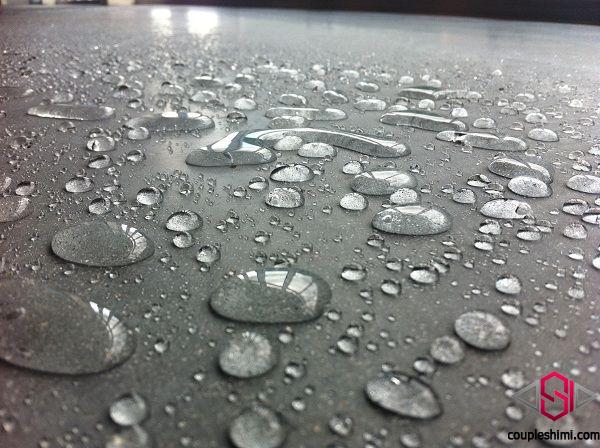Water absorption and its penetration in construction materials such as concrete, gypsum, stone, etc. due to the type of texture and particle size and also the presence of capillary cracks that are the factors of water transfer or absorption have long caused many problems such as efflorescence , Contamination on the surface, transfer of moisture and humidity and thus reducing the life and quality of building materials, especially in the facade and exterior surfaces of the building.
The pore size of most building materials is between 5 and 200 nm, while water molecules are less than 2 nm and contaminants that can enter the material directly or through water are often between 1 and 2 nm, which with Due to the hydrophilic nature of most mineral and natural materials used in construction, they easily penetrate into them and cause many problems.
Therefore, they have long tried to prevent the penetration of water and hydrophobic and sealing materials by using various polymer coatings such as paints and colored coatings. But firstly, due to the particles that make up these surface layers (which are generally more than 100 nanometers), they are not able to resist and prevent the penetration of free ions, and secondly, their lack of proper and long-term resistance to ultraviolet rays, which This shortens the life of these protective layers. Therefore, with the advancement of science and the use of nanotechnology, a revolution has occurred in the industry of materials and chemical additives, which also did not exclude facade protection materials.
Nano-penetrators for protection of facades and surfaces against moisture and humidity, free ions, sulfates and other corrosive and destructive agents are offered in the market on two families of water-based and solvent-based, which are monomers or polymers with a maximum size of 5 to 6 nanometers. Are included. These materials penetrate the space between the molecular particles and, by forming a membrane or mass, cause all or part of it to fill.
The filling operation is done in two ways:
1) Reactive fillers: These products include silanes, siloxanes, silicones, and silicates.
2) Non-reactive fillers: such as oils and organic products, it should be noted that this group of materials due to the high rate of decomposition by microorganisms in nature, have a relatively short useful life between 2 to 5 years.
Reactive products are grouped in two systems of water repulsion or hydrophobic and the other sealing, which due to the proximity in appearance of performance and behavior, generally their structural differences are not considered or both systems are used with the same purpose.
The maximum penetration in products that only cause hydrophobicity on the surface is 3 to 5 mm, which is not recommended for use in areas where there is a possibility of changing or decreasing the strength of the field for reasons such as severe lightning. The greater the penetration of these hydrophobic layers in the texture of the material, the higher the resistance to ultraviolet rays of the sun and therefore the amount of fall of these layers, which is an average of 5 to 10 microns per year, is reduced.
New smart sealing products include permanent smart nano-silicates.
Advantages of permanent smart nano-silicates:
1) No need to reapply and complete stability against sunlight
2) The possibility of neutralizing and removing existing efflorescence or removing sulfates from the surface layers
3) The possibility of creating sealing properties on wet and damp surfaces and removing moisture in the surface
4) No film or layer on the surface and the possibility of applying paint or coating with different chemical bases on them.
5) Increase impermeability resistance to chlorine ions up to 250% and frost resistance up to 300 glacial periods.
6) Dealing with positive and negative water pressures and preventing the peeling of paint or colored coatings due to moisture or gas pressure resulting from surface respiration.

